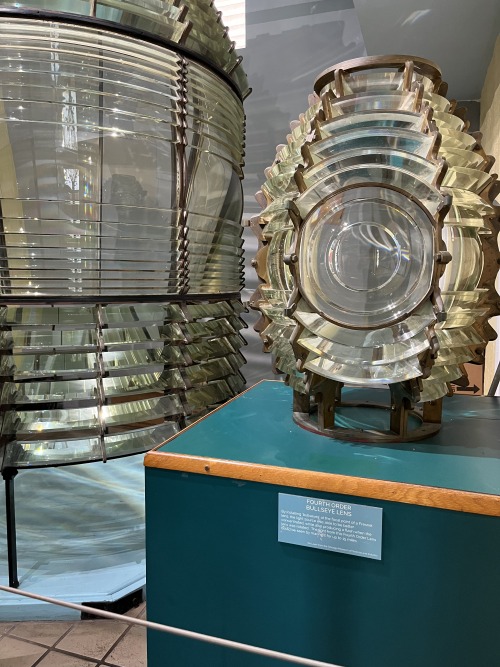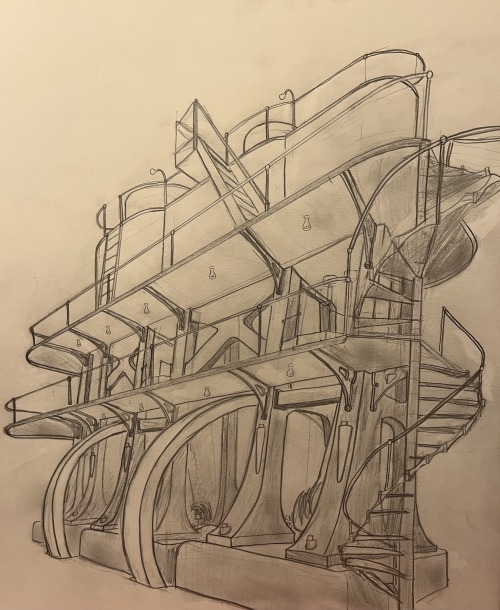
Well good day to ya! Have a seat, take a load off, and a have a look around. Do you like steam power? Obselete technology? Are you old fashioned and dull? Well, you my friend are in the right place!This blog is for all those who are like me and aren't all that enthusiastic about the modern age. You can expect photographs, drawings, fictional stories about my favorite things, and much more.You certainly won't get politics, religion, or controversy from me! I steer clear of that type of thing.Anyway, please enjoy yourself and, do say hello if you are so inclined.
18 posts
Lighthouse Tech







Lighthouse Tech
All of these pictures were taken at the Key West Lighthouse, a very well put together museum with a lighthouse that retains its original lens, as well as some remarkable exhibits in the keeper's house and the entrance building.
A link to the museum:
https://www.kwahs.org/key-west-lighthouse-keepers-quarters/
The pictures listed in the order they appear: 1. Key West Lighthouse; 2. The lighthouse's third order Fresnel lens; 3. Key West's colored sector glass pane; 4. A fifth order lens; 5. The twelve foot high, first order lens from Sombrero Key Lighthouse; 6. A fourth order lens; 7. A diagram showing some interesting information on lens sizes, the arrangement of the sections, and how far they could be seen.
Lighthouses are another interest of mine. I adore these things, and the remarkable engineering that went into them. If any building deserves to be described as a work of art, it's a lighthouse.
The Fresnel (pronounced Frey-nel) lenses are the ultimate blend of art, science, and engineering. They refract light over incredible distances from a comparatively small light source, and they are immeasurably beautiful, in my eyes. They are extremely intricate and very well put together, and if it weren't for the unstoppable march of "progress" and the extreme shortsightedness that seems to come with it, they would last a thousand years.
They come in many different shapes and sizes. Each was unique, as each one needed to fit the specific needs of the area. That, and they were all handmade. The different sizes were known as orders. First orders are on the upper end of the size spectrum, while sixth orders are on the lower end.
Some lighthouses received colored sections so that they could be identified from a distance, or to warn of obstructions. Many of these used sector glass panes in front of the lens, while on some, such as the Umpqua River Lighthouse, the lens itself was colored.
Lens rotation was accomplished via a clockwork mechanism. Some lenses rode on wheeled carriages, but these were not suitable for first order lenses. They were simply too heavy, there was too much friction, and the clockwork could not make them turn fast enough. So, the solution was to find a material for the lens to ride on that would be nearly frictionless. The solution they came up with was to fill a huge basin with mercury and place the lens and carriage on top of it. Mercury is very dense, so the lens actually floats on the surface of the mercury. It is so smooth that a person can rotate a three ton lens with their finger.
I might post some more photos from my trip to Key West. Stay tuned
More Posts from Mrtheengie
I spent long periods of time sitting on the top deck beside the cylinders, just watching the valves work. Goodness, I love this engine.
Us guys who were running her like to think that the ghost of Edward Pollard, the old chief engineer, was very happy with what we were doing.





Adventures at Woburn Waterworks. The best two days of my life.
Photo 1: Brass and Iron. Notice the modular construction of the steps. The main steam valve is in the top left. It has two wheels, one upstairs, and one at ground level.
Photo 2: Flywheel. The flywheel carries the momentum of the engine.
Photo 3: Low Pressure Side. The engine at Woburn is a compound, meaning it uses steam twice. The high pressure cylinder receives steam from the boiler. It exhausts into a receiver, i.e. a large tank between the cylinders, and the larger, low pressure cylinder uses this steam. A very efficient setup indeed.
Photo 4: Eccentrics. Unlike a locomotive or a ship's engine, a waterworks engine cannot reverse. It doesn't need to. So, why does each cylinder have two eccentrics? This engine is Corliss engine, or a four valve engine if you want to be more general. Each cylinder has four valves: two inlet, and two exhaust. It has two of each because most steam engines are double acting, meaning steam acts on both sides of the piston. These two sets of valves are each controlled by their own eccentric, allowing the engineers to make very precise adjustments to the valve timing should it become necessary. Also visible here is the belt which turns the fly-ball governor, yet another ingenious appliance from the steam age.
Photo 5: Down the Shaft. A view of the crankshaft, showing some of the gauges on the board. Since the engine was made a secret during the war, it has, very happily, retained ALL of its original gauges. Notice how the second on from the right reads "STEAM." Also notice the fact that the needle is not at zero...

The Railway with a Heart of Gold

Chestnut Hill Waterworks, Boston
Besides working on big engines on occasion (well, once) I also draw them.
Those who are unfamiliar with waterworks steam engines may watch the videos and look at the photographs I've posted of the Woburn engine and say, "That's a big engine!" And you're right, she is a big engine, in comparison to us people! Really, she is only about four stories high from the bottom of the pumps to the steam cylinders
Four stories? That's, quite literally, as high as a building! That's not small at all! Well, when you take a look at other engines in big waterworks in big cities, she is VERY small! The engines in Buffalo, New York, if memory serves, are about eight stories, and the engines in Cincinnati are eleven stories, or 104 feet in height! Those, the Cincinnati engines, are the largest in the world, and their building is now a museum, as well as a functioning waterworks.
THIS engine, which I have drawn, is housed at the former Chestnut Hill Waterworks, now the Metropolitan Waterworks Museum, in Boston, a short distance from Woburn.
Now, you may recall, if you have been here before, that I said Woburn is entirely unique, and here I am now, listing off museums where you can go and see other big waterworks engines. Well, the thing about these museums is that the engines are cold and unmoving. They are in good condition, though, and could very easily run again, given just a few months of work (that is not at all an exaggeration, by the way, Woburn was returned to steam, from derelict condition, in about... half a year if memory serves). Ah well, it's one of those things. At least they're still here!

LAMP
Taken at Woburn Waterworks in Massachusetts last year when I went to help out for a weekend and run the steam engine. More to come.